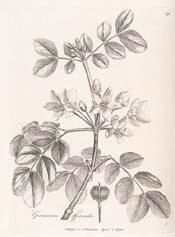
Botanical.com Home Page

|
Guaiacum
(Guaiacum officinale LINN.)
Click on graphic for larger image
|
Guaiacum
Botanical: Guaiacum officinale (LINN.)
Family: N.O. Zygophyllaceae
---Synonym---Lignum Vitae.
---Parts Used---Resin, bark, wood.
---Habitat---West Indian Islands. North Coast of South America.
---Description---An ornamental evergreen tree with pretty rich blue flowers, the trunk is a greenish-brown colour, the wood of slow growth but attains a height of 40 to 60 feet, stem almost always crooked, bark furrowed; the wood is extraordinarily heavy, solid and dense, fibres cross-grained; pinnate leaves, oval obtuse; fruit obcordate capsule; seeds solitary, hard, oblong. The old heart wood is dark green, the sap wood little in quantity and of a much lighter yellowish colour; the wood is largely used by turners, where weight is not an obstacle; it is very hard and durable, suitable for making black sheaves, pestles, pulleys, rulers, skittle boards, etc.; it has a slight acrid taste and is odourless, unless heated, when it emits an agreeable scent. The bark yields 1 per cent volatile oil of delicious fragrance.
Guaiacum sanctum. Habitat, Bahamas and South Florida) is also used for the same purposes as G. officinale; it is easily distinguished from the latter, by its five-celled fruit, and its oblong leaflets, six to eight to each leaf. The leaves are sometimes used as a substitute for soap.
Guaiacum Resin. This is obtained from both the above trees and is procured by raising one end of the log and firing it; this melts the resin, which runs out of a hole cut in the other end, and is then caught into vessels. The resin is found in round or ovoid tears; some are imported the size of walnuts, but usually it is in large blocks; these break easily; the fracture is clean and glassy, in thin pieces, colour yellow-reddish brown. The powder is grey, and must be kept in dark-coloured bottles, as exposure to the light and air soon turns it green.
---Medicinal Action and Uses---The wood is very little used in medicine; it obtained a great reputation about the sixteenth century, when it was brought into notice as a cure for syphilis and other diseases; later on the resin obtained from the wood was introduced and now is greatly preferred, for medicinal use, to the wood. The wood is sometimes sold by chemists in the form of fine shavings, and as such called Lignum Vitae, which are turned green by exposure to the air, and bluish green by the action of nitric fumes. This test proves its genuiness.
It is a mild laxative and diuretic. For tonsilitis it is given in powdered form. Specially useful for rheumatoid arthritis, also in chronic rheumatism and gout, relieving the pain and inflammation between the attacks, and lessening their recurrence if doses are continued. It acts as an acrid stimulant, increasing heat of body and circulation; when the decoction is taken hot and the body is kept warm, it acts as a diaphoretic, and if cool as a diuretic. Also largely used for secondary syphilis, skin diseases and scrofula.
---Dosage---Of the wood 30 to 60 grains, Decoction, 2 oz. to 4 oz. in a pint of water. Fluid extract, 1/2 to 1 drachm. Guaiacum tincture, B.P. and U.S.P., 1/2 to 1 drachm. Ammoniated tincture Guaiacum, B.P. and U.S.P., 1/2 to 1 drachm. Resin, 5 to 15 grains. Guaiacum mixture, B.P., 1/2 to 1 fluid ounce. Guaiacum Resin Lozenges, B.P., 1 to 6 may be taken.
[Top]
Common Name Index
A MODERN HERBAL Home Page
Bear in mind "A Modern Herbal" was written with the conventional wisdom of the early 1900's. This should be taken into account as some of the information may now be considered inaccurate, or not in accordance with modern medicine.
© Copyright Protected 1995-2024 Botanical.com
|

